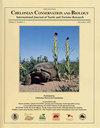Factors Affecting Predation on Wood Turtle (Glyptemys insculpta) Nests in the Upper Peninsula of Michigan
IF 0.8
4区 生物学
Q3 ZOOLOGY
引用次数: 3
Abstract
Abstract Depredation rates on turtle nests can be very high, resulting in low recruitment to populations. Understanding predator foraging habits and nesting ecology of turtles is essential for the long-term management of threatened turtle species. Cues used by predators to locate wood turtle (Glyptemys insculpta) nests were investigated by creating simulated nests with 1 of 4 treatments: soil disturbance, water with turtle scent, soil disturbance plus turtle scent, or distilled water. Nest predators primarily used soil disturbance cues for locating nests. Additionally, artificial nests with buried chicken eggs were created at varying distances from the river and monitored for predation. Nest predation decreased as nest distance from the river increased. These data can be used to develop strategies for more effective management of this threatened species.密歇根州上半岛木龟巢穴捕食的影响因素
对海龟巢穴的掠夺率可能非常高,导致对种群的补充很低。了解海龟捕食者的觅食习惯和筑巢生态对濒危海龟物种的长期管理至关重要。本研究采用土壤干扰、龟味水、土壤干扰加龟味水和蒸馏水四种处理方法中的一种来模拟木龟(Glyptemys insculpta)的巢,研究了捕食者定位木龟巢的线索。巢穴捕食者主要利用土壤扰动线索来定位巢穴。此外,他们还在离河流不同距离的地方建造了埋有鸡蛋的人工鸟巢,并监测它们的捕食情况。随着巢离河流的距离增加,巢的捕食减少。这些数据可用于制定更有效地管理这种受威胁物种的策略。
本文章由计算机程序翻译,如有差异,请以英文原文为准。
求助全文
约1分钟内获得全文
求助全文
来源期刊
CiteScore
1.70
自引率
14.30%
发文量
17
审稿时长
>12 weeks
期刊介绍:
Chelonian Conservation and Biology is a biannual peer-reviewed journal of cosmopolitan and broad-based coverage of all aspects of conservation and biology of all chelonians, including freshwater turtles, marine turtles, and tortoises. Manuscripts may cover any aspects of turtle and tortoise research, with a preference for conservation or biology. Manuscripts dealing with conservation biology, systematic relationships, chelonian diversity, geographic distribution, natural history, ecology, reproduction, morphology and natural variation, population status, husbandry, community conservation initiatives, and human exploitation or conservation management issues are of special interest.

 求助内容:
求助内容: 应助结果提醒方式:
应助结果提醒方式:


